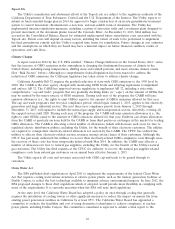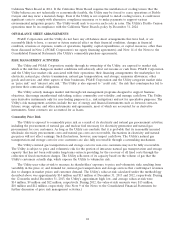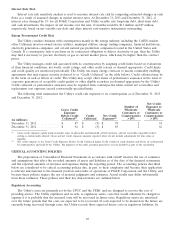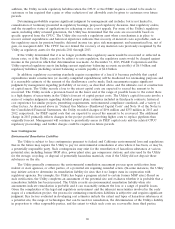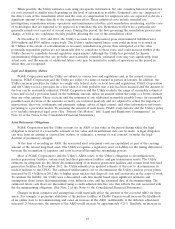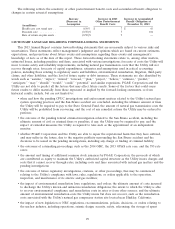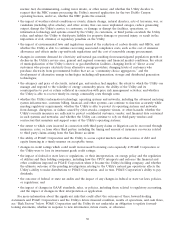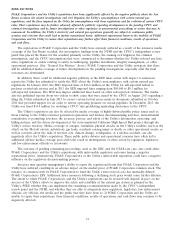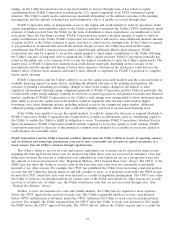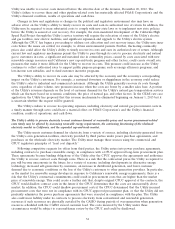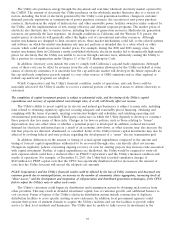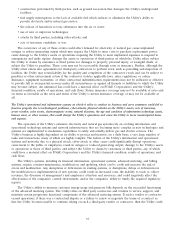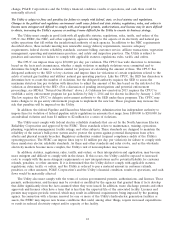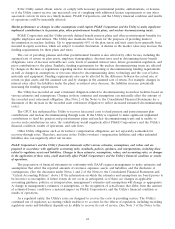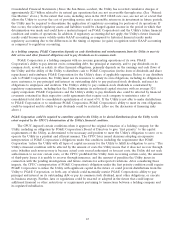PG&E 2013 Annual Report Download - page 39
Download and view the complete annual report
Please find page 39 of the 2013 PG&E annual report below. You can navigate through the pages in the report by either clicking on the pages listed below, or by using the keyword search tool below to find specific information within the annual report.ratings. As the Utility has incurred costs it has been unable to recover through rates, it has relied on equity
contributions from PG&E Corporation to maintain the 52% equity component of its CPUC-authorized capital
structure. The Utility’s equity needs could increase materially depending on the ultimate outcome of the pending
investigations and the amount of natural gas and transmission costs it is unable to recover through rates.
PG&E Corporation relies on independent access to the capital and credit markets to fund its operations, make
capital expenditures, and contribute equity to the Utility as needed to maintain the Utility’s CPUC-authorized capital
structure, if funds received from the Utility (in the form of dividends or share repurchases) are insufficient to meet
such needs. Since the San Bruno accident, PG&E Corporation has issued a material amount of equity to fund its
equity contributions to the Utility. PG&E Corporation forecasts that it will need to issue additional material amounts
of equity in 2014 as the Utility continues to incur costs that it cannot recover through rates. If the Utility is required
to pay penalties in an amount that exceeds the amount already accrued, the Utility may need further equity
contributions that PG&E Corporation may need to fund through additional dilutive share issuances. PG&E
Corporation also may be required to access the capital markets to fund equity contributions to the Utility following
the Utility’s issuance of long-term debt to maintain the Utility’s capital structure. PG&E Corporation primarily has
relied on the public sale of its common stock to raise the funds it contributes to meet the Utility’s equity needs. The
market price of PG&E Corporation common stock could decline materially depending on the outcome of the
investigations and the amount and timing of future share issuances. Declines in the stock price could increase the
dilutive effect of future stock issuances and make it more difficult or expensive for PG&E Corporation to complete
future equity offerings.
PG&E Corporation’s and the Utility’s ability to access the capital and credit markets and the costs and terms of
available financing depend on many factors, including the ultimate outcome of the pending investigations, the
outcome of pending ratemaking proceedings, changes in their credit ratings, changes in the federal or state
regulatory environment affecting energy companies generally or PG&E Corporation and the Utility in particular, the
overall health of the energy industry, volatility in electricity or natural gas prices, and general economic and financial
market conditions. If PG&E Corporation’s or the Utility’s credit ratings were downgraded to below investment grade,
their ability to access the capital and credit markets would be negatively affected and could result in higher
borrowing costs, fewer financing options, including reduced access to the commercial paper market, additional
collateral posting requirements, which in turn could affect liquidity and lead to an increased financing need.
If the Utility were unable to access the capital markets, it could be required to decrease or suspend dividends to
PG&E Corporation. PG&E Corporation also would need to consider its alternatives, such as contributing capital to
the Utility, to enable the Utility to fulfill its obligation to serve. To maintain PG&E Corporation’s dividend level in
these circumstances, PG&E Corporation would be further required to access the capital or credit markets. PG&E
Corporation may need to decrease or discontinue its common stock dividend if it is unable to access the capital or
credit markets on reasonable terms.
PG&E Corporation’s and the Utility’s financial condition depends upon the Utility’s ability to recover its operating expenses
and its electricity and natural gas procurement costs and to earn a reasonable rate of return on capital investments, in a
timely manner from the Utility’s customers through regulated rates.
The Utility’s ability to recover its costs and earn its authorized rate of return can be affected by many factors,
including the time lag between when costs are incurred and when those costs are recovered in customers’ rates and
differences between the forecast or authorized costs embedded in rates (which are set on a prospective basis) and
the amount of actual costs incurred. (See ‘‘Regulatory Matters—2014 General Rate Case’’ above.) The CPUC or the
FERC may not allow the Utility to recover costs on the basis that such costs were not reasonably or prudently
incurred or for other reasons. For example, the CPUC has prohibited the Utility from recovering a material portion
of costs that the Utility has already incurred, and will continue to incur, as it performs work under the PSEP, in part,
because the CPUC found that such costs were incurred as a result of imprudent management. The CPUC may order
the Utility to propose cost-sharing methods for certain costs or the Utility may decide for other reasons not to seek
recovery of certain costs. In either case, the Utility would incur costs that are not recovered through rates. (See
‘‘Natural Gas Matters’’ above.)
Further, to serve its customers in a safe and reliable manner, the Utility may be required to incur expenses
before the CPUC approves the recovery of such costs. The Utility is generally unable to recover costs incurred
before CPUC authorization is obtained, unless the CPUC authorizes the Utility to track costs for potential future
recovery. For example, the Utility requested that the CPUC allow the Utility to track costs incurred in 2012 under
the PSEP before the CPUC approved the plan. The CPUC did not address the Utility’s request and as a result the
33


